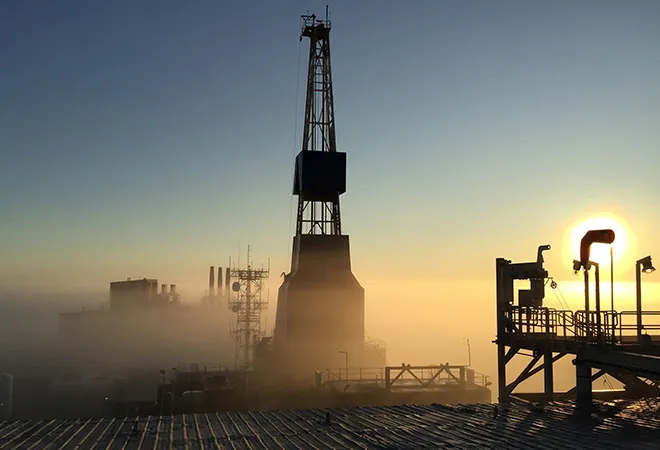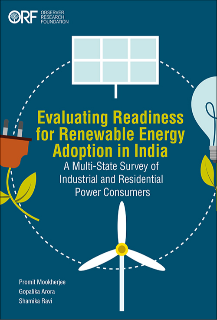
For the Islamic Republic of Iran, oil is a GDP-threatening export addiction. Iran holds the world’s fourth-largest proved reserves of crude oil amounting to 12.9 percent of global proven crude oil reserves,
<1> after Venezuela, Saudi Arabia, and Canada
<2> and is home to the world’s second-largest proved reserves of natural gas after Russia.
<3> The 8 May 2018 US sanctions
<4> will make Iran bleed, as fossil fuels contribute more than 53 percent of the country’s exports,
<5> and account for close to 15 percent of its USD 440 billion GDP.
<6> The US sanctions come at a time when Iran is trying to diversify its way out of its oil addiction and increase its non-oil exports to 15 percent of GDP by 2020,
<7> as part of its Sixth Development Plan targets.
Following the lifting of sanctions in 2016, Iran experienced a rise in GDP growth rate from -1.3 percent in the previous year to 13.4 percent. <8> This was followed by a consistent decline in inflation from 34.7 percent in 2013 to 9.0 percent in 2017. <9> This, though, has not caused a discernible ripple effect in the job sector because of the volatility of economic growth. The unemployment rate has increased since, from 10.6 percent in 2014 to 13.1 percent in 2017. <10> To create jobs, Iran’s non-oil economy needs to take off. <11> Expanding its non-oil economy would also unlock the country’s growth potential and diversify from dependence on a single commodity, with its automotive sector well positioned to be one of the frontrunners.
To create jobs, Iran’s non-oil economy needs to take off. Expanding its non-oil economy would also unlock the country’s growth potential and diversify from dependence on a single commodity.
India, for its part, is the world’s third-largest consumer of oil, with 85 percent of its crude oil and 34 percent of its natural gas requirements being fulfilled by imports. <12> These proportions are expected to jump five-fold by 2040 and will represent a quarter of the total increase in global energy consumption over the period. <13> In 2016, India imported 215 million tonnes of crude oil and at 13 percent, Iran stood third among India’s biggest oil suppliers, after Saudi Arabia and Iraq at 18 percent each. <14>
| Table 1. India’s imports of petroleum oils and oils obtained from bituminous minerals crude from Iran |
|
2010-2011 |
2011-2012 |
2012-2013 |
2013-2014 |
2014-2015 |
2015-2016 |
2016-2017 |
2017-2018 |
|
| From Iran |
9.2 |
11.6 |
9.6 |
8.4 |
7.0 |
4.3 |
8.9 |
8.9 |
|
| Growth (%) |
-9.6 |
26.2 |
-17.6 |
-11.9 |
-16.6 |
-38.2 |
107.9 |
0.8 |
|
| India’s total import of commodity |
92.7 |
134.2 |
144.5 |
143.6 |
116.4 |
65.9 |
70.7 |
87.4 |
|
| Growth (%) |
19.5 |
44.8 |
7.7 |
-0.6 |
-18.9 |
43.4 |
7.3 |
23.6 |
|
| Share of Iran (%) |
9.9 |
8.7 |
6.6 |
5.9 |
6.1 |
6.5 |
12.6 |
10.3 |
|
Except where specified, all values in billion dollars. Source: Department of Commerce, Ministry of Commerce and Industry
Apart from rising oil prices that benefit the world’s most organised cartel — the powerful OPEC (Organisation of Petroleum Exporting Countries), of which Iran is a member — and large global commodity market speculators, the US’ political move has economic consequences. In today’s globalised world, these consequences afflict not only one country, Iran, but its trading partners, from France and Germany that are rebelling against the move, to Russia and China that will use it to strengthen their own geopolitical and moral presence in the rebalancing of world power.
With the imposition of sanctions on Iran, India is left with two options: either find other avenues of oil imports or risk facing the US sanctions. As far as India’s oil imports from Iran go, the sanctions will compel it to import from other arms of the OPEC cartel, which are set to benefit from rising crude oil prices that were up by one percent in 18 days to USD 78.34 on 27 May 2018 from USD 77.60 on 9 May 2018. <15> Or, it could mean a greater dependence on shale from the US. This knee-jerk rise reflects the short-term nature of markets and has begun to put pressure on the world’s two fastest-growing and largest oil-importing large economies, India and China. In the longer time horizon, however, the US shale growth could swing the market back into surplus. <16>
| Table 2. India-Iran Trade |
|
2010-2011 |
2011-2012 |
2012-2013 |
2013-2014 |
2014-2015 |
2015-2016 |
2016-2017 |
2017-2018 |
|
| Export to Iran |
2.5 |
2.4 |
3.4 |
4.9 |
4.2 |
2. 8 |
2.4 |
2.7 |
|
| % Growth |
34.6 |
-3.2 |
39.0 |
48.4 |
-16.1 |
-33.3 |
-14.8 |
11.8 |
|
| Import from Iran (including oil) |
10.9 |
13.8 |
11.6 |
10.3 |
8.9 |
6.3 |
10.5 |
11.1 |
|
| % Growth |
-5.4 |
26.3 |
-15.9 |
-11.0 |
-13.2 |
-29.9 |
67.5 |
5.8 |
|
| Total Trade between Iran and India |
13.4 |
16.2 |
14.9 |
15.3 |
13.1 |
9.1 |
12.9 |
13.8 |
|
| % Growth |
0.2 |
20.8 |
-7.8 |
2.3 |
-14.1 |
-31.0 |
42.2 |
6.9 |
|
| India’s Total trade |
619.6 |
795.3 |
791.1 |
764.6 |
758.4 |
643.3 |
660.2 |
768.9 |
|
| % Share of Iran in India’s Total Trade |
2.16 |
2.04 |
1.89 |
2.00 |
1.73 |
1.41 |
1.95 |
1.79 |
|
|
|
|
|
|
|
|
|
|
|
|
Except where specified, all values in billion dollars. Source: Department of Commerce, Ministry of Commerce and Industry
Bilateral trade between India and Iran has increased since the JCPOA was formed but as the growth of oil imports is significantly declining, India also imports fertilisers, organic chemicals and plastics. However, these add up to less than USD 1 billion. <17> Besides, the US sanctions may not impact them, as Minister of External Affairs Sushma Swaraj stated that India will abide only by the United Nations’ sanctions <18> and not by those of “any country”. How that stance plays out in the larger scheme of things remains to be seen. After all, at USD 74.3 billion, the US is India’s second-largest trading partner <19> after China and one with which it had a USD 22.9-billion trade surplus.
References
<1> OPEC Annual Statistical Bulletin, 2017,
<2> Country Analysis Brief: Iran, U.S. Energy Information Administration, 9 April 2018, p. 5, Accessed on 10 May 2018
<3> Country Analysis Brief: Iran, U.S. Energy Information Administration, 9 April 2018, p. 13, Accessed on 10 May 2018
<4> On President Trump's Decision to Withdraw From the JCPOA, Press Statement, Mike Pompeo, Secretary of State, Washington, DC, 8 May 2018, Accessed on 21 June 2018
<5> IMF Country Report No. 18/94, International Monetary Fund, p.11, 7 March 2018
<6> Islamic Republic of Iran: Overview, The World Bank, 1 April 2018, Accessed on 24 May 2018
<7> Ibid, IMF Country Report, p. 12
<8> https://data.worldbank.org/indicator/NY.GDP.MKTP.KD.ZG?locations=IR
<9> https://data.worldbank.org/indicator/FP.CPI.TOTL.ZG?locations=IR
<10> Iran Economic Monitor, World Bank, Spring 2017.
<11> Iran Economic Monitor, Towards Reintegration, Fall 2016, p. 1, World Bank Group, Accessed on 25 May 2018
<12> Energy Indicators (2015-16) at a Glance, Energy Statistics 2017, Central Statistics Office, Ministry of Statistics and Programme Implementation, Government of India, p. 89, Accessed on 14 May 2018
<13> India: a rising force in global energy demand, India Energy Outlook, World Energy Outlook 2015, International Energy Agency, 2015, p. 464, Accessed on 14 May 2018
<14> Government of India, Petroleum and Natural Gas, India Minerals Yearbook, 2017.
<15> Brent Crude Oil Spot Price, YCharts, Accessed on 27 May 2018
<16> Fitch: US Sanctions Against Iran To Affect Oil Supply Balance, Fitch Ratings, 10 May 2018, Accessed on 27 May 2018
<17> International Trade Statistics
<18> India says it only follows UN sanctions, not unilateral US sanctions on Iran, Reuters, 28 May 20128, Accessed on 21 June 2018
<19> 2017: Trade in Goods with India, United States Census Bureau, Accessed on 21 June 2018
The views expressed above belong to the author(s). ORF research and analyses now available on Telegram! Click here to access our curated content — blogs, longforms and interviews.



 For the Islamic Republic of Iran, oil is a GDP-threatening export addiction. Iran holds the world’s fourth-largest proved reserves of crude oil amounting to 12.9 percent of global proven crude oil reserves,
For the Islamic Republic of Iran, oil is a GDP-threatening export addiction. Iran holds the world’s fourth-largest proved reserves of crude oil amounting to 12.9 percent of global proven crude oil reserves,  PREV
PREV



